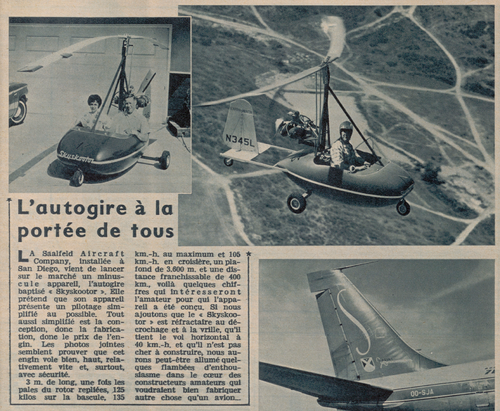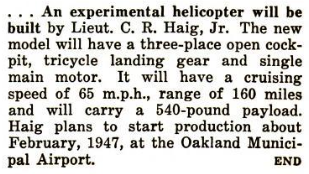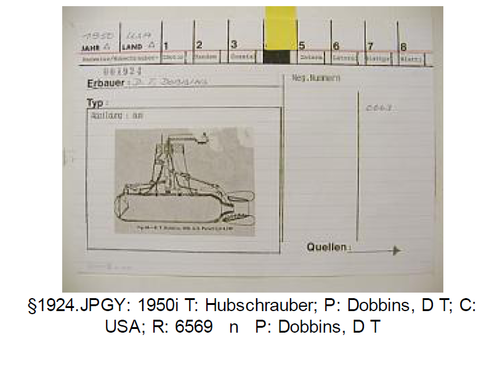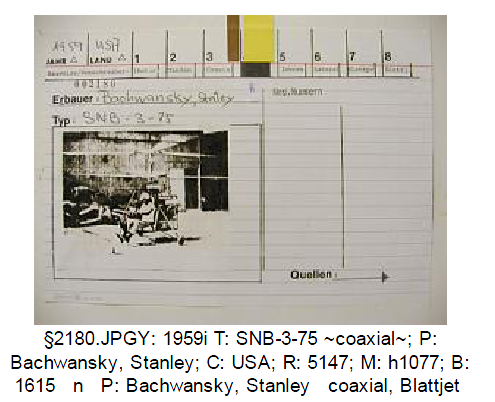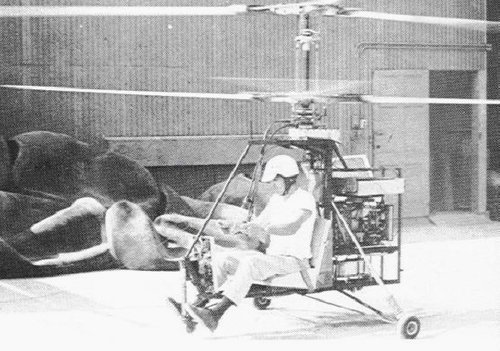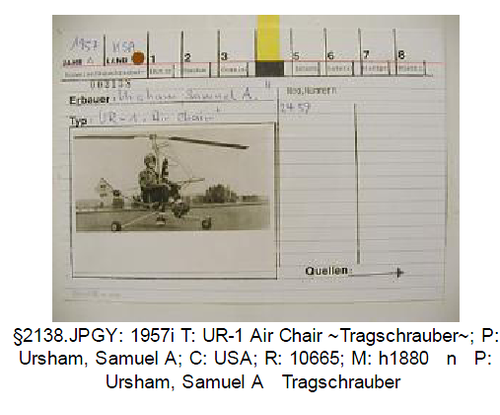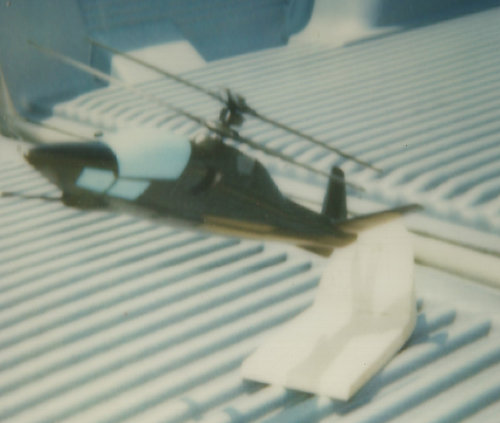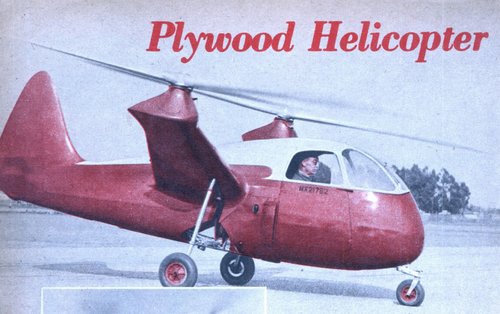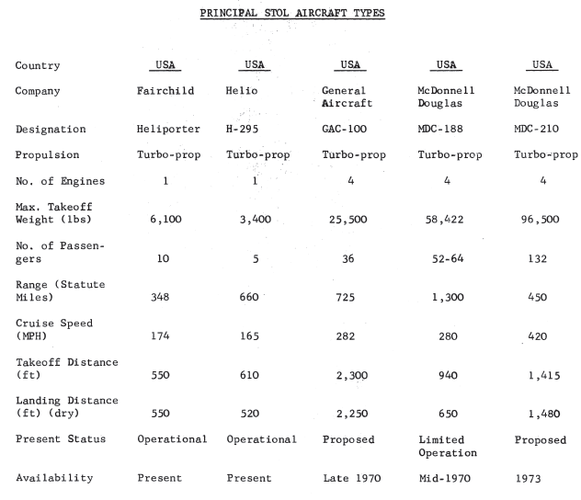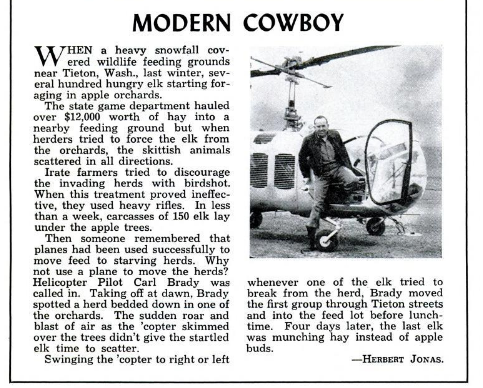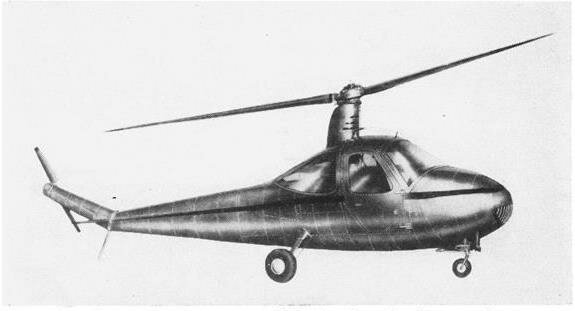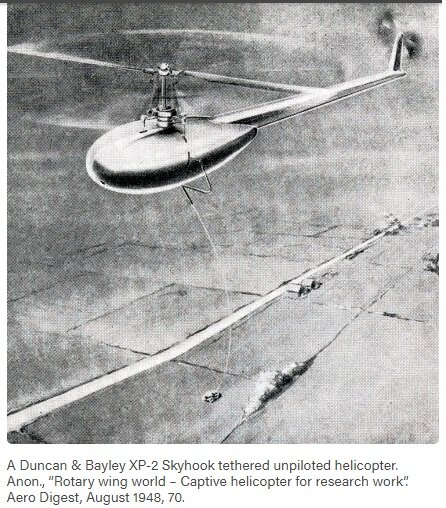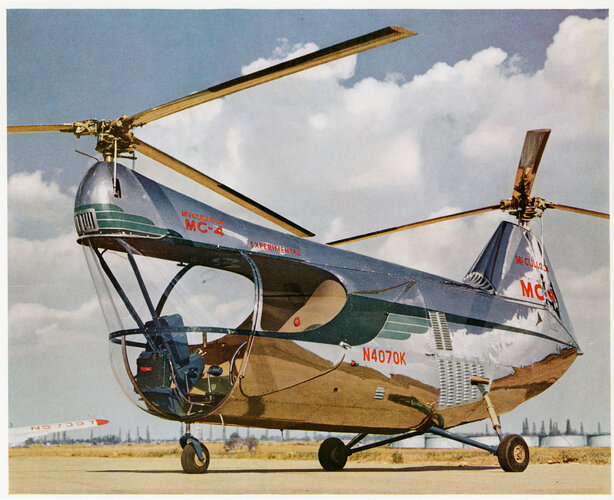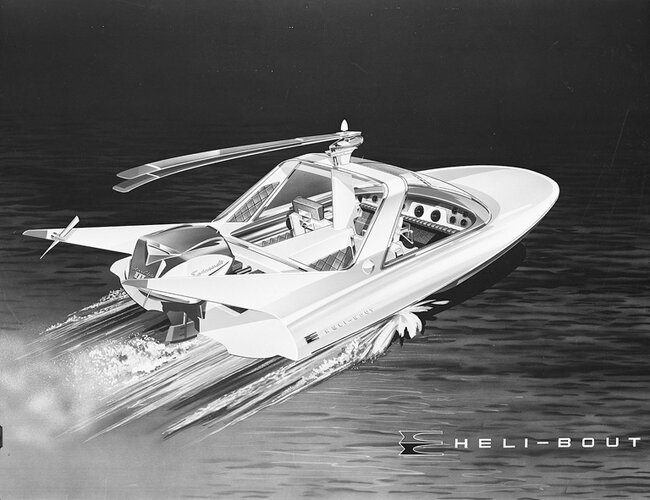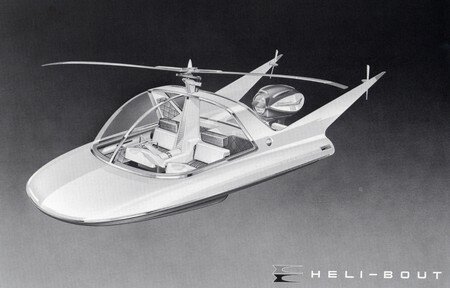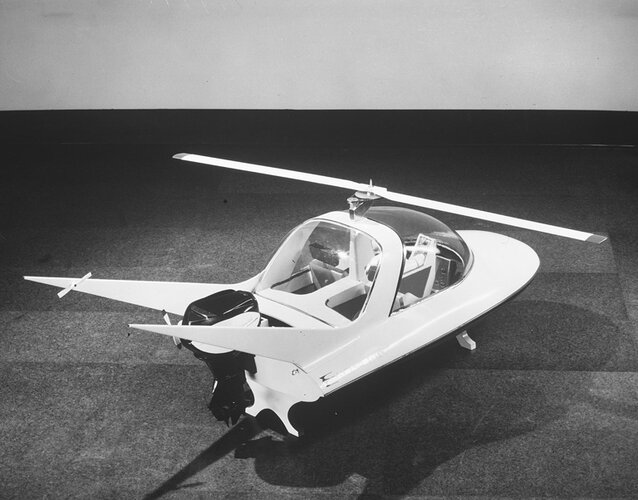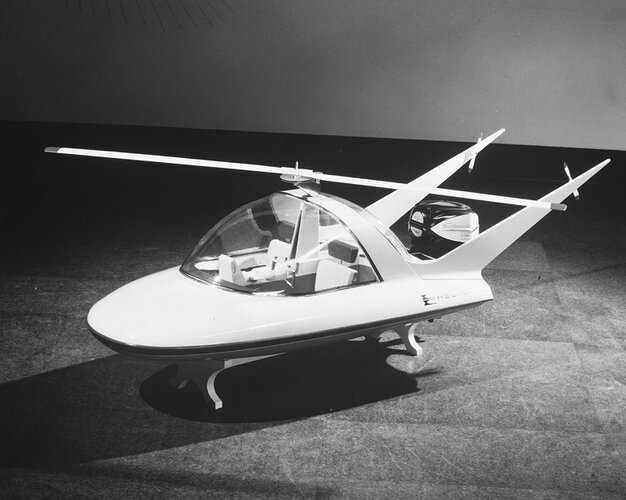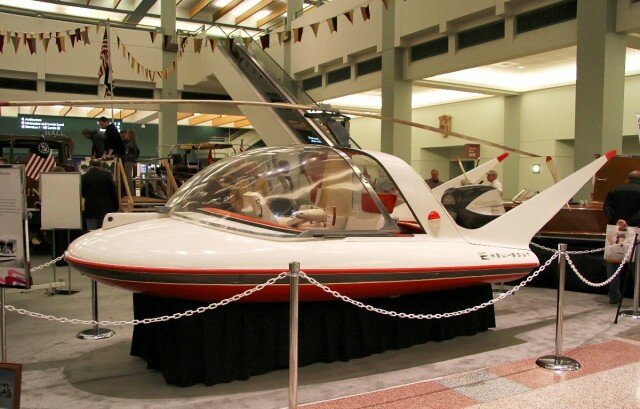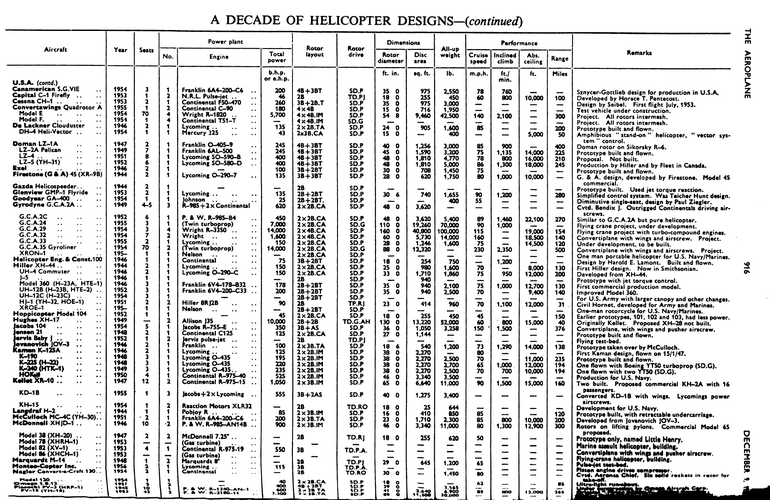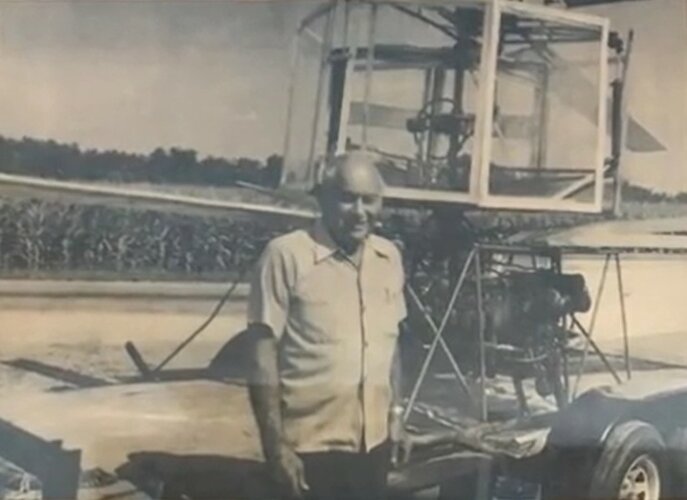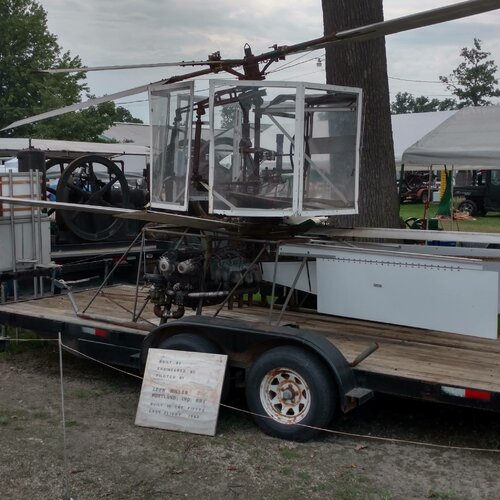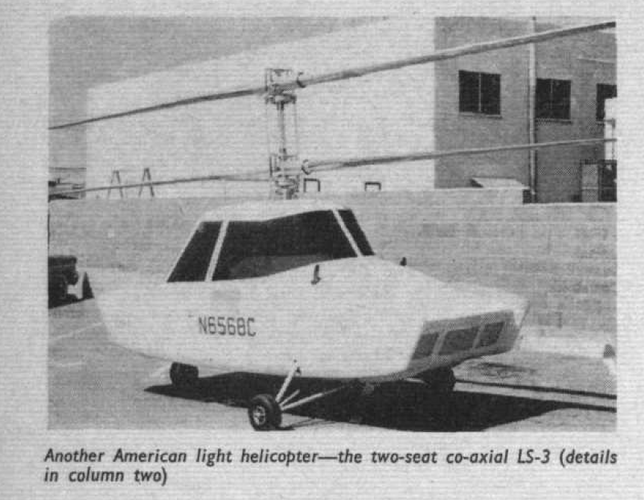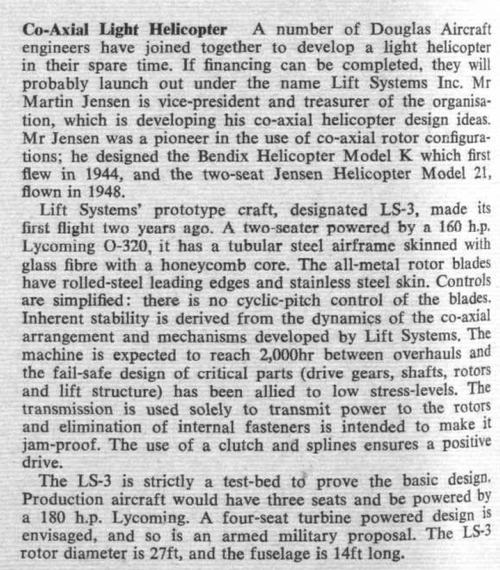You are using an out of date browser. It may not display this or other websites correctly.
You should upgrade or use an alternative browser.
You should upgrade or use an alternative browser.
Little-known American Helicopter Prototypes & Projects
- Thread starter hesham
- Start date
From Aviation magazine 1965,
here is a Schentzow helicopter.
That is the Scheutzow Model B (AKA: Scheutzow Bee), built by Webb Scheutzow.
A recent bundle of magazines included a number of 1946 and 1947 issues of American Helicopter magazine. The December 1946 issues had a "Helicopter Panorama of 1946" spread and the following designs were presented. I've included a couple that were actually from Canada for completeness.
As my dear Mark found this drawing to a Haig helicopter Project,also the same designer created a helicopter,
actually built and called HK-1.
http://www.aviastar.org/helicopters_eng/haig_hk-1.php
I compiled a bit of history behind Haig-K and the HK-1 here, but the possibility of a connection between the concept drawing and Haig-K's work is an interesting puzzle, as the caption reads that it was being developed in California, but Haig Kurkjian was in Philadelphia at the time. Is the name "Haig" just coincidental?
EDIT: Okay I’m dumb and didn’t read the additional attachment. They are different companies.
Last edited:
Alright I've been doing more digging and in several 1940s-era printed sources (Google Books results, too many to list and the info is fragmented) Chester R. Haig, Jr's company is mentioned to having been developing the three-seat Haig Model R-2, and that they planned on developing the four-seat Model R-3 after they moved operations to the Oakland Municipal Airport in 1946 (I think this is what is depicted in the concept drawing). Henry S. Tremper, one of the Coast Guard's first helicopter pilots, consulted as a test pilot for the company.
This snippet from Flying Magazine, November 1946, is the most intact paragraph I can find, but the chronology doesn't seem to match what is described in the other sources:
This snippet from Flying Magazine, November 1946, is the most intact paragraph I can find, but the chronology doesn't seem to match what is described in the other sources:
Attachments
Yes. The Haig Helicopter Company was formed by Chester R. Haig, Jr. sometime in the 1940s. The Haig-K Aircraft Corporation, which developed the HK-1, was formed by Haig Kurkjian in 1952.
- Joined
- 26 May 2006
- Messages
- 34,810
- Reaction score
- 15,695
Hi,
here is a strange helicopter Project,developed by D. Dobbins,maybe the same person
who built a roadable flying car and called David Dobbins;
http://kulturserver-nds.de/home/hubtest/medien/Typenkartei3953xGUN7x9T3Z7.pdf
here is a strange helicopter Project,developed by D. Dobbins,maybe the same person
who built a roadable flying car and called David Dobbins;
http://kulturserver-nds.de/home/hubtest/medien/Typenkartei3953xGUN7x9T3Z7.pdf
Attachments
- Joined
- 26 May 2006
- Messages
- 34,810
- Reaction score
- 15,695
Hi,
here is a coaxial rotor small helicopter,designed by Mr. Stanley Bachwansky in 1959.
http://kulturserver-nds.de/home/hubtest/medien/Typenkartei3953xGUN7x9T3Z7.pdf
here is a coaxial rotor small helicopter,designed by Mr. Stanley Bachwansky in 1959.
http://kulturserver-nds.de/home/hubtest/medien/Typenkartei3953xGUN7x9T3Z7.pdf
Attachments
I posted a picture of a Grumman proposal that was in the collection a while back. Well joy of joys, I just added a minty in the box Grumman Design 376 AAFSS with the original stand that will help with the lineage. Seems Kaman was involved as well. Enjoy!
Any indication of scale?
A somewhat better picture of the Bachwansky co-axial helicopter.
Some info:
single-seat helicopter
one ….hp Evinrude (liquid cooled) outboard piston engine
main rotor diameter 16ft
DETAILS: The SNB 3-75 small co-axial rotor homebuilt helicopter was designed and built by Mr. Stan Bachwansky and mainly intended to obtain date for the projected larger Turbodyne 740 (not built). The SNB 3-75 was built in prototype form only and was completed in 1969, but destroyed in a fire and almost certainly was never test flown. (Possibly ground tests were performed only). The aircraft was powered by one (modified) Evinrude liquid cooled outboard engine.
Production: 1
Stan Bachwansky, Arcadia, CA EAA # 19314
Some info:
single-seat helicopter
one ….hp Evinrude (liquid cooled) outboard piston engine
main rotor diameter 16ft
DETAILS: The SNB 3-75 small co-axial rotor homebuilt helicopter was designed and built by Mr. Stan Bachwansky and mainly intended to obtain date for the projected larger Turbodyne 740 (not built). The SNB 3-75 was built in prototype form only and was completed in 1969, but destroyed in a fire and almost certainly was never test flown. (Possibly ground tests were performed only). The aircraft was powered by one (modified) Evinrude liquid cooled outboard engine.
Production: 1
Stan Bachwansky, Arcadia, CA EAA # 19314
Attachments
- Joined
- 26 May 2006
- Messages
- 34,810
- Reaction score
- 15,695
Hi,
Mr. Samuel A. Ursham designed a little helicopter,called UR-1 Air-Chair in 1957.
http://kulturserver-nds.de/home/hubtest/medien/Typenkartei3953xGUN7x9T3Z7.pdf
Mr. Samuel A. Ursham designed a little helicopter,called UR-1 Air-Chair in 1957.
http://kulturserver-nds.de/home/hubtest/medien/Typenkartei3953xGUN7x9T3Z7.pdf
Attachments
- Joined
- 25 July 2007
- Messages
- 4,297
- Reaction score
- 4,183
Mr. Samuel A. Ursham designed a little helicopter,called UR-1 Air-Chair in 1957.
Not Ursham but Urshan after its builder Sam Urshan of San Diego, CA (who was a PR guy for Rohr Aircraft Corporation).
Also not a helicopter but a rotor kite or (rotary-wing glider).
The UR-1 Air Chair (N20K) was originally designed as a tip-jet helicopter (with a fuel tank mounted above the rotor rub to feed out to the tips by gravity and then centrifugal force). The inspiration came from Urshan's WW2 and Korean War bomber experiences. [1] He wanted portable, one-man helicopters which could act as onboard rescue devices in the event of a crash landing by US bombers.
Lack of suitable pulsejet engines turned Urshan's UR-1 from a tip-jet helicopter into a towable gyrocopter glider. The UR-1 itself was constructed out of surplus parts. In 1957, Sam Urshan was said to be working on a small, piston-engined helicopter similar to his UR-1. Does anyone know if there was ever a 'UR-2'?
BTW: Samuel A. Urshan was also an author - eg: Homebuilt Helicopter Booklet (1956); Homebuilt Helicopter Directory (1957); Homebuilt Designer-Builder Handbook (c.1958); Homebuilt Airplane Directory (1958); Aerobatic Handbook and Fiberglass Handbooklet both of 1962; etc..
Source: Chula Vista Star-News, Chula Vista, CA, 14 March 1957, page 16
________________________
[1] Captain Urshan had flown on 29 bombing missions in WW2 and a further 45 missions over Korea.
- Joined
- 26 May 2006
- Messages
- 34,810
- Reaction score
- 15,695
I made that model for Allysonca back when I worked for Hughes!Amazing project Allysonca,
many thanks for sharing us, and in the same picture,what was this ?.
allysonca
Thank you Mr5oa,
and sorry for late answer,but that means it was designed by Hughes,right ?,
or you meant it was just your idea ?.
Last edited:
1635yankee
Recovering aeronautical engineer
- Joined
- 18 August 2020
- Messages
- 550
- Reaction score
- 753
Is this thread limited to little known because never-built helicopters and other rotorcraft?
If not, I'll offer the Cessna CH-1 (https://www.verticalmag.com/features/cessna-in-the-helicopter-age/) and Siebel's YH-24 (Siebel was bought by Cessna; the CH-1 was a product), Glid Doman's LZ-5 (about a dozen made. After Doman's company failed, he worked at Boeing Vertol, Hamilton Standard, and founded another company in the late 1970s. He lived until 2016, dying at the age of 95.
If not, I'll offer the Cessna CH-1 (https://www.verticalmag.com/features/cessna-in-the-helicopter-age/) and Siebel's YH-24 (Siebel was bought by Cessna; the CH-1 was a product), Glid Doman's LZ-5 (about a dozen made. After Doman's company failed, he worked at Boeing Vertol, Hamilton Standard, and founded another company in the late 1970s. He lived until 2016, dying at the age of 95.
- Joined
- 26 May 2006
- Messages
- 34,810
- Reaction score
- 15,695
Thank you 1635Yankee for those Infos,
and the thread talks about little known helicopter prototypes and Projects,the production one
is in anther section,and the popular companies is not included,such as Bell,Boeing,Doman,Enstrom,
Kaman,Hiller,Gyrodyne,Kellett,McDonnell,Vertol,Lockheed Piasecki,Higgins,Nagler,Jovanovich and
Sikorsky,all of them have a seperated topics
and the thread talks about little known helicopter prototypes and Projects,the production one
is in anther section,and the popular companies is not included,such as Bell,Boeing,Doman,Enstrom,
Kaman,Hiller,Gyrodyne,Kellett,McDonnell,Vertol,Lockheed Piasecki,Higgins,Nagler,Jovanovich and
Sikorsky,all of them have a seperated topics
- Joined
- 9 October 2009
- Messages
- 21,928
- Reaction score
- 13,549

Ivo Zdarsky Is Waiting Out the End Times in His Own Utah Ghost Town
The Iron Curtain escapee, DIY aviator, and thriving entrepreneur is ready for anything.
Zdarsky does, however, live in a big house. In an airplane hangar, actually, in Lucin, Utah, an abandoned railroad town of which he’s the sole inhabitant.
“I don’t like walls,” he says. “So half of it is a hangar, and the other half of it is a man cave.” The building is 100 feet by 50 feet, and the man cave is “just one big giant room” inside, next to a workspace and two airplanes: a Cessna Skyhawk* and an experimental craft that’s “like a helicopter and an airplane in one machine.”
Zdarsky spends most of his days alone, tinkering around with different pet projects—the helicopter-plane is just one of the things he’s constantly working on and thinking about.
Zdarsky hasn’t always lived alone. He moved to Lucin in 2007, from Long Beach, California, where he worked for 24 years, growing and running an airplane propeller manufacturing business called Ivoprop, which he still owns. Propellers made by Ivoprop are highly regarded in the flying world. They’re mainly used on small personal airplanes, hang-gliders, and novelty aircraft—flying machines with surprising proportions and odd, geometric appendages.
Zdarsky tells the story of Ivoprop, which he founded in 1984, with characteristic understatement. “When you fly—when you’re building something to fly—you kind of need a propellor,” he says. “So it started with that. I had to make my own in Czechoslovakia, so I had some idea how to make it better [than other manufacturers]. So I made it better, and people were buying it. So I made more and more, and that’s how it works.”

ORIGINAL CAPTION: Zdarsky says his experimental tilt-rotor craft is “like a helicopter and an airplane in one machine.” Courtesy Ivo Zdarsky
- Joined
- 26 May 2006
- Messages
- 34,810
- Reaction score
- 15,695
Hi,
here is a strange Project from Fairchild,1970,powered by one turboprop
engine,and could accommodate ten passenger,I can't ID it ?.
here is a strange Project from Fairchild,1970,powered by one turboprop
engine,and could accommodate ten passenger,I can't ID it ?.
Attachments
Last edited:
- Joined
- 9 October 2009
- Messages
- 21,928
- Reaction score
- 13,549
I think I may have solved the mystery. The Fairchild Hiller Heliporter, or alternatively Heli-Porter, was the original name/s of the Turbo-Porter, Fairchild's licence-built version of the Pilatus Porter:


- Joined
- 11 March 2012
- Messages
- 3,244
- Reaction score
- 3,171
This helicopter was built during the late 1940s by Bell.From Flying 1950-2,
I can ID this helicopter ?!.
That is the second version of Bell 47.
The first version had an open cockpit and wheels.
This second version improved pilot comfort by adding a full bubble canopy.
The third version traded wheels for landing skids.
Last edited:
- Joined
- 28 January 2008
- Messages
- 635
- Reaction score
- 511
Glenview Metal Products Inc GMP-1 Flyride
A two seat helicopter dating from 1954 promoted as the helicipter with "single stick control" by the company. Glenview were based in Delanco, New Jersey and the simplification of the controls resulted in easy maneuvering, ascent, descent, forward, reverse and side ways flight. The Flyride also had a car type accelerator floor pedal arrangement. The damping of vibration and the development of the single stick control system was undertaken by William Hunt.
The Flyride was due to be marketed in 1954 at an estimated cost of $10,000.
The designed was developed from an earlier William Hunt design which was flown in 1947 with a 90hp Franklin as the Hunt Hummingbird.
Flyride Details:
Powerplant: 1x Lycoming O-290D (140 hp)
Rotor width: 30 ft 6 in
Length: 35 ft 7 in
Rate of ascent: 1,200 ft per min
Ceiling: 15,000 ft
Gross weight: 1,655 lb
Empty weight: 1,150 lb
Useful load: 505 lb
Maximum speed: 118 mph
Cruise speed: 95 mph
Range: 300 miles
Seating: Two
Sources:
Aviation Week 22 February 1954 issue
See also Hesham reference at https://www.secretprojects.co.uk/threads/helicopters-and-autogyros.898/#post-7528
A two seat helicopter dating from 1954 promoted as the helicipter with "single stick control" by the company. Glenview were based in Delanco, New Jersey and the simplification of the controls resulted in easy maneuvering, ascent, descent, forward, reverse and side ways flight. The Flyride also had a car type accelerator floor pedal arrangement. The damping of vibration and the development of the single stick control system was undertaken by William Hunt.
The Flyride was due to be marketed in 1954 at an estimated cost of $10,000.
The designed was developed from an earlier William Hunt design which was flown in 1947 with a 90hp Franklin as the Hunt Hummingbird.
Flyride Details:
Powerplant: 1x Lycoming O-290D (140 hp)
Rotor width: 30 ft 6 in
Length: 35 ft 7 in
Rate of ascent: 1,200 ft per min
Ceiling: 15,000 ft
Gross weight: 1,655 lb
Empty weight: 1,150 lb
Useful load: 505 lb
Maximum speed: 118 mph
Cruise speed: 95 mph
Range: 300 miles
Seating: Two
Sources:
Aviation Week 22 February 1954 issue
See also Hesham reference at https://www.secretprojects.co.uk/threads/helicopters-and-autogyros.898/#post-7528
Attachments
Last edited:
- Joined
- 26 May 2006
- Messages
- 34,810
- Reaction score
- 15,695
Duncan & Bayley XP-2 Skyhook tethered unpiloted helicopter,
Really, do you know what a Duncan & Bayley XP-2 Skyhook is, off the top of your head, my reading friend? By the way, please accept my apologies for repeating the name of this pilotless aircraft / drone / remotely piloted vehicle / unmanned aerial vehicle. Yours truly just finds it very cool, but I digress. If truth be told, I must say I had never heard of the Skyhook before the photo above came across my path. Would you like to know more about it? No? Well, too bad, so sad.
Our story began in the United States around 1944-45, with 2 members of the small team (30 to 35 people) that put together at least 1 prototype of the Bell Model 47, a world famous type of helicopter mentioned in a July 2017 issue of our blog / bulletin / thingee. These men were John E. Duncan and William Hewitt Bayley.
A model airplane maker since 1929 or so, Duncan actually held several records. Seemingly during the 1930s, he was the assistant of a forgotten engineer who was trying to develop a helicopter. Sadly, Roger Sweet died before he could complete a prototype. Duncan finished this helicopter but could not find the money necessary to complete its development. He joined the staff of the Airplane Division of American aeronautical giant Curtiss-Wright Corporation in 1940. Duncan began to work for Bell Aircraft Corporation, a company mentioned in a July 2017 issue of the aforementioned blog / bulletin / thingee, in 1943. By 1947, he was the chief of model research.
Bayley, on the other hand, was a mechanic at Lockheed Aircraft Corporation who joined the staff of Bell Aircraft in 1941. By 1947, he was the assistant of the company’s commercial sales manager.
The use of models to help with the development of the Model 47 gave Duncan and Bayley an idea. They founded Duncan & Bayley Incorporated in 1945 to perfect a tiny pilotless single rotor helicopter powered by an electric motor using current supplied through a short insulated cable attached to a metal tube. This model would be the key element of a simulator used to train helicopter pilots. The 2 men completed a prototype of the helicopter in February 1947. Even though 10 or so of these machines were made, the simulator itself may not have been put in production.
Was the designer from Canada ?.

 ingeniumcanada.org
ingeniumcanada.org
Really, do you know what a Duncan & Bayley XP-2 Skyhook is, off the top of your head, my reading friend? By the way, please accept my apologies for repeating the name of this pilotless aircraft / drone / remotely piloted vehicle / unmanned aerial vehicle. Yours truly just finds it very cool, but I digress. If truth be told, I must say I had never heard of the Skyhook before the photo above came across my path. Would you like to know more about it? No? Well, too bad, so sad.
Our story began in the United States around 1944-45, with 2 members of the small team (30 to 35 people) that put together at least 1 prototype of the Bell Model 47, a world famous type of helicopter mentioned in a July 2017 issue of our blog / bulletin / thingee. These men were John E. Duncan and William Hewitt Bayley.
A model airplane maker since 1929 or so, Duncan actually held several records. Seemingly during the 1930s, he was the assistant of a forgotten engineer who was trying to develop a helicopter. Sadly, Roger Sweet died before he could complete a prototype. Duncan finished this helicopter but could not find the money necessary to complete its development. He joined the staff of the Airplane Division of American aeronautical giant Curtiss-Wright Corporation in 1940. Duncan began to work for Bell Aircraft Corporation, a company mentioned in a July 2017 issue of the aforementioned blog / bulletin / thingee, in 1943. By 1947, he was the chief of model research.
Bayley, on the other hand, was a mechanic at Lockheed Aircraft Corporation who joined the staff of Bell Aircraft in 1941. By 1947, he was the assistant of the company’s commercial sales manager.
The use of models to help with the development of the Model 47 gave Duncan and Bayley an idea. They founded Duncan & Bayley Incorporated in 1945 to perfect a tiny pilotless single rotor helicopter powered by an electric motor using current supplied through a short insulated cable attached to a metal tube. This model would be the key element of a simulator used to train helicopter pilots. The 2 men completed a prototype of the helicopter in February 1947. Even though 10 or so of these machines were made, the simulator itself may not have been put in production.
Was the designer from Canada ?.

Now be honest, can you tell me what a Duncan & Bayley XP-2 Skyhook is? | The Channel
Really, do you know what a Duncan & Bayley XP-2 Skyhook is, off the top of your head, my read
Attachments
- Joined
- 26 May 2006
- Messages
- 34,810
- Reaction score
- 15,695
Umbaugh U-17 :tandem two seat gyrocopter with a slim low-set tailboom
and a single fin and tiny T-tailplane.
From Ailes 19/4/1958,
maybe this one was U-17 ?.
From Airlifes; Helicopters & Rotorcraft.
Attachments
Armin Derer
In dire need for coffee
- Joined
- 10 June 2021
- Messages
- 70
- Reaction score
- 99
What was the publication date of the book? Might be useful for research.Found this helicopter in an old Soviet book. It is described as the "Scove helicopter", although I'm not positive about how this should be spelt, nor am I 100% sure it was actually an American project. Help, anyone?
- Joined
- 13 June 2007
- Messages
- 2,172
- Reaction score
- 3,073
RavenOne
ACCESS: Top Secret
- Joined
- 18 June 2008
- Messages
- 1,000
- Reaction score
- 2,657
Kinda reminds me of Frank Robinson intention when he designed and built R22...Hi,
Mr. Horace T. Pentecost founded Hoppi-Copter Inc company,he designed the HX-1 or
Model-100,a one man copter with two contra-rotating rotors,followed by Model-101 &
Model-102,evolved into the 1950 experimental Firefly with an 18' rotor powered by
tip ramjets.
He also designed a very cheap single seat Helicopter,also there was a Model-103 and
Model-104.
Google Sites: Sign-in
Access Google Sites with a personal Google account or Google Workspace account (for business use).sites.google.com
I have done the Robinson Helicopter Safety Course and our instructor told us when he worked with the first UK distributors in the late 70s, early 80s there was an advert both in magazines and even tabloids saying along the lines of "why go up the mortorway in 70 mph when you can go up country at 100kts" or something along those lines.
cheers
persil
All rotorcraft enthusiast
True. I have just came across those publications.Mr. Samuel A. Ursham designed a little helicopter,called UR-1 Air-Chair in 1957.
Not Ursham but Urshan after its builder Sam Urshan of San Diego, CA (who was a PR guy for Rohr Aircraft Corporation).
Also not a helicopter but a rotor kite or (rotary-wing glider).
The UR-1 Air Chair (N20K) was originally designed as a tip-jet helicopter (with a fuel tank mounted above the rotor rub to feed out to the tips by gravity and then centrifugal force). The inspiration came from Urshan's WW2 and Korean War bomber experiences. [1] He wanted portable, one-man helicopters which could act as onboard rescue devices in the event of a crash landing by US bombers.
Lack of suitable pulsejet engines turned Urshan's UR-1 from a tip-jet helicopter into a towable gyrocopter glider. The UR-1 itself was constructed out of surplus parts. In 1957, Sam Urshan was said to be working on a small, piston-engined helicopter similar to his UR-1. Does anyone know if there was ever a 'UR-2'?
BTW: Samuel A. Urshan was also an author - eg: Homebuilt Helicopter Booklet (1956); Homebuilt Helicopter Directory (1957); Homebuilt Designer-Builder Handbook (c.1958); Homebuilt Airplane Directory (1958); Aerobatic Handbook and Fiberglass Handbooklet both of 1962; etc..
Source: Chula Vista Star-News, Chula Vista, CA, 14 March 1957, page 16
________________________
[1] Captain Urshan had flown on 29 bombing missions in WW2 and a further 45 missions over Korea.

Homemade gyrocopter and gliders around the world | Anybody want? | Facebook
Anybody want?
 www.facebook.com
www.facebook.com

1950s HOMEBUILT HELICOPTER DIRECTORY Names 1957 Picture Photo Urshan Amateur | eBay
Find many great new & used options and get the best deals for 1950s HOMEBUILT HELICOPTER DIRECTORY Names 1957 Picture Photo Urshan Amateur at the best online prices at eBay! Free shipping for many products!
www.ebay.com

Homebuilt Helicopter Handbook by Urshan, Sam - 1956
Find Homebuilt Helicopter Handbook by Urshan, Sam - 1956
Maybe someone of you have it in a PDF?
I was able to extract the photo of Mr Urshan's Air-Chair:
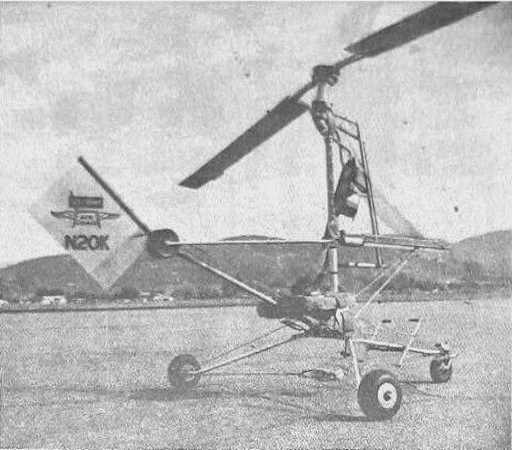
Last edited:
persil
All rotorcraft enthusiast
Homebuilt Helicopter Handbook by Mr Sam Urshan is now available to download on facebook (16 pages, 9 files):
 www.facebook.com
www.facebook.com
Log into Facebook
Log into Facebook to start sharing and connecting with your friends, family, and people you know.
 www.facebook.com
www.facebook.com
Motocar
I really should change my personal text
- Joined
- 16 May 2014
- Messages
- 1,065
- Reaction score
- 1,111
Cutaway in progress...!Good Day All -
Came across this image over the weekend sortingt hru Museum material. Nice image of the MC-4.
Enjoy the Day! Mark
- Joined
- 26 May 2006
- Messages
- 34,810
- Reaction score
- 15,695
Heli-Bout,what was this ?,

 mariothemultipla.wordpress.com
mariothemultipla.wordpress.com

W&W 3A – The Heli-bout
As promised, here’s a mini post on another fantastic collaboration between Evinrude and designer Brooks Stevens and it certainly falls into the Weird and Wacky catagory! Boat manufacturers Ev…
Attachments
persil
All rotorcraft enthusiast
Hello All,
Here's a coaxial helicopter, made in the 1950s by Leon Miller of Portland,Oregon, Indiana.
Other than what can be gleaned from these images, information seems to be lacking ...
Here's a coaxial helicopter, made in the 1950s by Leon Miller of Portland,
Paul Leon Miller Obituary - scroll through the video, and pause @ 8:20
Other than what can be gleaned from these images, information seems to be lacking ...
Attachments
Last edited:
persil
All rotorcraft enthusiast
Similar threads
-
Little-known postwar U.S. rotorcraft prototypes
- Started by Stargazer
- Replies: 3
-
Antoine Gazda's « Helicospeeder »: a cousin of Sikorsky's VS-300
- Started by Stargazer
- Replies: 8
-
-
Kaiser Fleetwings XH-10 « Twirleybird » helicopter prototype (1944)
- Started by Stargazer
- Replies: 11
-
Westland VTOL convertiplane projects
- Started by overscan (PaulMM)
- Replies: 51


